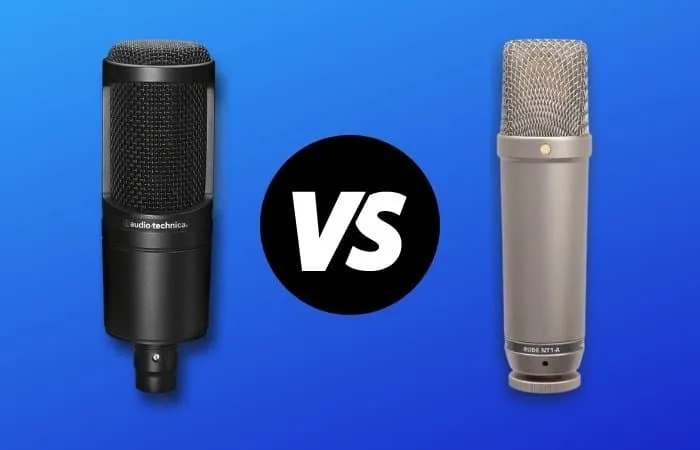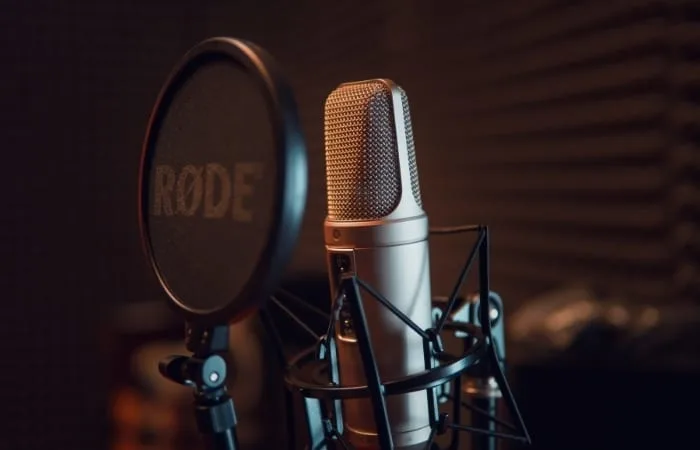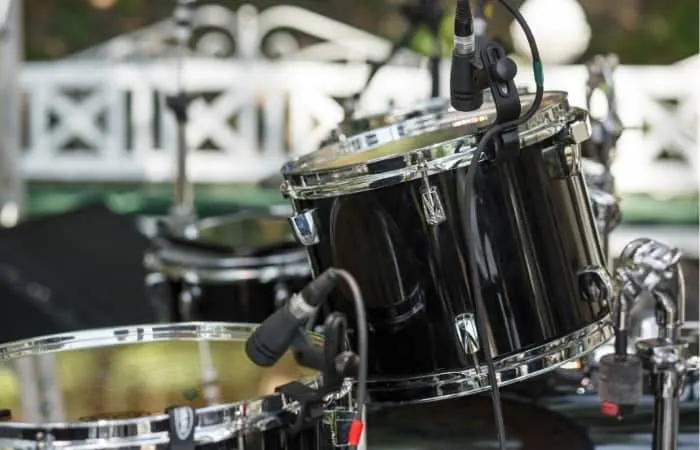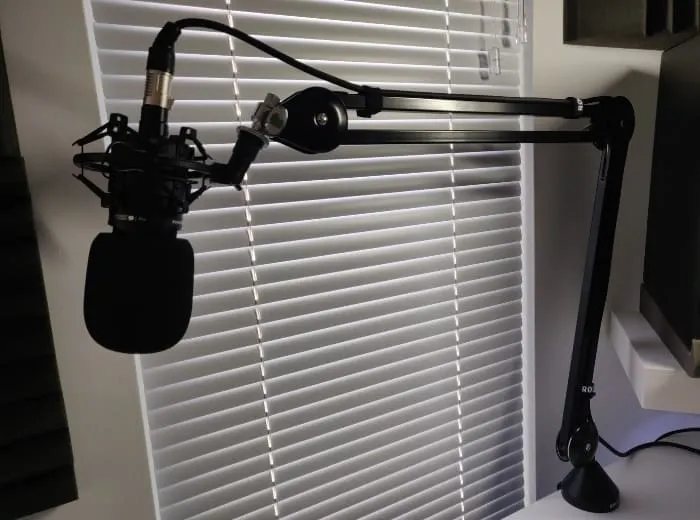In this article, we pit two heavyweight entry-level microphones head to head, the .
With so many options now on the market, it is always tricky to decide which is the best to buy.
This article will talk about two microphones that are great workhorses, well priced, and perfect for any home studio, also commonly found in professional studios.
Both these mics are fantastic options, and either would sit nicely in your home studio.
I currently have the AT2020 microphone from Audio Technica in my own lab, so I know firsthand what a great bang for your buck mic it is.
I’ve got to admit, it was a close toss-up deciding between these two mics, and ultimately it came down to the price.
Continue reading to find how these two microphones compare and which one is best suited for you.

in A Hurry?
Check out the latest prices here:
| Image | Product | Features | Price |
|---|---|---|---|
 | Audio-Technica AT2020 |
| Latest Price |
 | Audio-Technica AT2020USB+ |
| Latest Price |
 | Rode NT1-A |
| Latest Price |
Audio Technica AT2020
When you think about well-known brands, you think about Technica. They make some of the best mics on the market and have a wide selection of types and prices.
The AT2020 is probably one of the best for home recording, entry-level , because of its affordability and quality.
It is a , which means that it will pick up from the front, and it will need to be powered from an external power supply called phantom power.
Any will require phantom power to work. There are no battery options.
About the (range of that the can reproduce), it is the same as any large-diaphragm : 20Hz-20kHz
It has a cool design, with its thick black cast metal and the capsule (housing for the diaphragm) seems to be well protected with a rigid wire mesh.
It is light (0.76 lbs) and overall feels pretty durable.
I also like that Technica included a case with it to keep it protected if you plan on taking it out and about, although be aware it’s not the most padded case I’ve seen.
If you are looking for a for , it is essential to know that this does well with deep dark voices. Perfect for male vocalists and rap vocals, it has a very crisp and bold sound and is very sensitive, picks up a lot.
By adding some EQ and compression, you will have a fantastic Although it has a secondary layer of mesh that helps reduce popping, it is vital to use a proper pop shield when .
Also suitable for recording loud sounds like horns and closed miked instruments, it has a dynamic range of 124dB at 1KHZ and maximum SPL.
Overall the AT2020 is perfect for recording pretty much anything, especially and instruments like an .
Let’s take a look at the AT2020 specs:
- Polar Pattern: Cardioid
- Microphone type: Condenser
- Frequency Response: 20Hz-20kHz
- Output Impedance: 100 Ohms
- Connector: Three-pin (XLR), male
- Max SPL: 144dB SPL
- Sensitivity : -37dB
- Self-Noise : 20dB
One of the negatives of this mic is that the sound seems to be quite bright so that it might feel like it has a slight lack of body.
Also, the storage bag doesn’t have much padding, and you need to have an XLR cable because it doesn’t come with it.
Something to have in mind is that you will need to own an audio interface for it to work as it requires phantom power unless you opt for the AT2020 USB version.
AT2020USB+
In 2013 the AT2020 released its USB version, which is pretty similar to the regular AT2020 but doesn’t require any additional gear to work because the Gain and Headphone Mix adjusters are built-in.
The phantom power is supplied via the USB cable. So this is a perfect option if you don’t want any additional gear like an interface or mixer console to power it up.
It also comes with a built-in headphone jack to control the latency with the mix knob, and it allows you to control how much of the ‘s direct signal you will get and how much of the computer’s will be played back.
It has a handy a gain dial to manage the level of the signal aswell.
In general terms, the quality is pretty much the same as the AT2020XLR.
The main difference is its ease of use. You just connect it to the computer, and you are ready to go.
A perfect option for beginners. It is an ideal for podcasting or voice-over work.
Either you choose the XLR or the , I think it is an excellent option for your home studio, it will let you record anything you need to, and the quality of a great brand supports you.
Audio-Technica AT2020USB+ USB Microphone
- Condenser microphone with USB output for digital recording
- High-quality A/D converter with 16 bit, 44.1/48 kilohertz sampling rate for superb audio
- Headphone jack with volume control allows you to monitor the microphone signal with no delay
- Mix control allows you to blend your microphone signal and prerecorded audio
Rode NT1A
Another excellent for an entry-level home studio, the Rode, is probably one of the most used microphones nowadays.
It will give you a very accurate representation of what’s being recorded, and for this reason, it will fit with ease in any mix.
I would go for a if I’m looking for the right for , acoustic guitars, and similar instruments.
Although it has a bright , I would say brighter than the AT2020, and it can also make your voice warm and clear.
I like its design better than the AT2020, it is also a fixed , and it will need an to connect.
Being released in 2003, it has proved to last in time and is still going strong. Although a little higher in price, it is still affordable and a great choice when looking for increased sensitivity.
Especially useful with , it will pick up any volume and dynamic of your voice.
It has a sensitivity of -31dB and a max SPL of 137, and a great range, so you won’t have to do a lot afterward.
Since the SPL (loudest the can take) is slightly lower than the AT2020, it might not be the best choice when recording closed-musked instruments.
One of the drawbacks of the is that the capsule doesn’t come with proper padding, so when , you will have some issues with sibilance (s’s or t’s); although it comes with a , you might have to upgrade the to have better results.
Let’s look at the specs for the NT1A:
- Polar Pattern: Cardioid
- Microphone type: Condenser
- Frequency Response: 20Hz-20kHz
- Output Impedance: 100 Ohms
- Connector:Three-pin (XLR), male
- Max SPL: 137dB SPL
- Sensitivity: -32dB
- Self-Noise: 5dB
Something that is also good from the NT1- A Is its flat frequency response, which means that whatever you record will be close to the original.
Its brightness, bass attenuation, and slight issues with sibilance are some of the cons of this mic; however, it is a great, long-lasting option.
Here’s a comparison table to see both mics side by side.
| Feature | Rode NT1-A | AT2020 |
| Release Date | 2003 | 2004 |
| Color | Silver | Black |
| Noise Level | 5dB | 20dB |
| Sensitivity | -32dB | -37dB |
| Type | Condenser | Condenser |
| Polar Pattern | Cardioid | Cardioid |
| Max SPL | 137dB | 140dB |
| Output Impedance | 100 Ohms | 100 Ohms |
| Phantom Power Required? | YES | YES |
| Connector | XLR | XLR |
The Importance of a Good Quality Microphone
When you get more into either composing, producing, recording music, or even podcasting, you will need to invest in your equipment, and a good is probably one of the first things you want to own.
You can have the best quality interface, PA, or mixer that your budget can afford, but if you don’t have a source adequately miked, you won’t achieve much.
I would say that owning mics, learning how to handle them, and continually using them is the best way to ensure consistency in your sonic work.

Microphones are this sort of magic wand that captures an instant and makes it last forever in a track.
The quality of the capture will affect the final result of the you want to share with the world, so having a is the secret weapon of any recording engineer, producer, or self-recording artist.
Before getting into more details, I would like to start with some basic concepts that might be helpful if you are just beginning in this world of recording music and microphones usage.
Studio Mics and Stage Mics
Live and studio are two different worlds, and for this reason, specific microphones will perform better for one or the other.
The studio microphones are designed to capture subtleties; you want them to be as optimized as possible to capture a wide range and be as accurate as possible.
On the other side, stage mics need to be sturdy and built to resist humidity, feedback and be able to handle noise.
Even though you can find microphones with a great response to both duties, live and studio, mics are probably the most common ones at the studio and offer the highest fidelity, with a wide frequency range, low noise, and excellent impulse response.
A significant difference between both worlds is also placement.
A stage must be placed close to the source to achieve that high feedback resistance and usually have the low frequencies attenuated to compensate for that proximity’s bass boat.

In opposition, Studio microphones have a deeper low end and are very sensitive to noise; they are usually more flexible. They can work either close or further away from the source.
There are various pick-up patterns, which tell you how the picks up (its directionality) and its sensitivity based on the ‘s orientation.
So you have mics that are sensitive to in all directions (omnidirectional), from the front and rear (figure eight or bidirectional), one direction (cardioid), and so on.
AT2020 vs NT1A – Final Thoughts
As you can see, both microphones, in general, are quite similar, so it would depend on what you need them for and what your final budget is.
There’s certainly a difference in the prices, with being the Rode NT1 coming in more expensive than the AT2020.
The Rode NT1-A is excellent for and is as close to the real you can find in that range of prices.
The downside: sibilation, bass attenuation, and some people complain that it sounds too bright.’
The AT2020 seems to be an excellent all-around working , durable, and very affordable.
Its downside noise level appears slightly higher than average, and it doesn’t come with a .
In my home studio, I have the AT2020, and I’ve got to say I’m pleased with it. You are getting a that doesn’t break the bank, which is important when starting music production.
With the money I saved, I could buy the excellent Rode Boom Arm, and a .

Check out the Rode Boom Arm here:
The Shock Mount
Koolertron Universal Microphone Shock Mount
- This professional suspension shock mount isolates most studio condenser mics from physical vibration, and stand noise.
- Made of high-quality metal and high elasticity rope.
- It can protect the microphone all-around with high elasticity wrap roping design, which makes the microphone more convenient to install and prevent the microphone from falling.
Here’s the Pop Filter:
Whichever microphone you decide to go for in the end, you can’t really go wrong with either of these options. Both of them are more than capable in a home studio setup.






 Want to connect with other music producers for help and guidance?
Want to connect with other music producers for help and guidance?